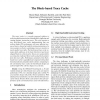Free Online Productivity Tools
i2Speak
i2Symbol
i2OCR
iTex2Img
iWeb2Print
iWeb2Shot
i2Type
iPdf2Split
iPdf2Merge
i2Bopomofo
i2Arabic
i2Style
i2Image
i2PDF
iLatex2Rtf
Sci2ools
81
Voted
ISCA
1999
IEEE
1999
IEEE
The Block-Based Trace Cache
The trace cache is a recently proposed solution to achieving high instruction fetch bandwidth by buffering and reusing dynamic instruction traces. This work presents a new block-based trace cache implementation that can achieve higher IPC performance with more efficient storage of traces. Instead of explicitly storing instructions of a trace, pointers to blocks constituting a trace are stored in a much smaller trace table. The block-based trace cache renames fetch addresses at the basic block level and stores aligned blocks in a block cache. Traces are constructed by accessing the replicated block cache using block pointers from the trace table. Performance potential of the blockbased trace cache is quantified and compared with perfect branch prediction and perfect fetch schemes. Comparing to the conventional trace cache, the block-based design can achieve higher IPC, with less impact on cycle time. Results: Using the SPECint95 benchmarks, a 16-wide realistic design of a block-based t...
Related Content
| Added | 03 Aug 2010 |
| Updated | 03 Aug 2010 |
| Type | Conference |
| Year | 1999 |
| Where | ISCA |
| Authors | Bryan Black, Bohuslav Rychlik, John Paul Shen |
Comments (0)

